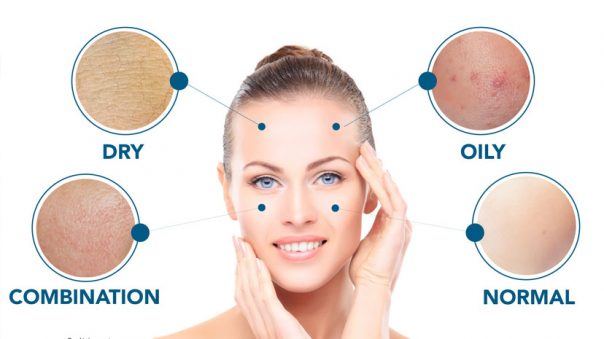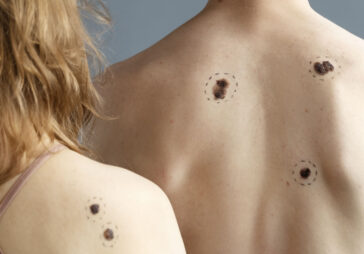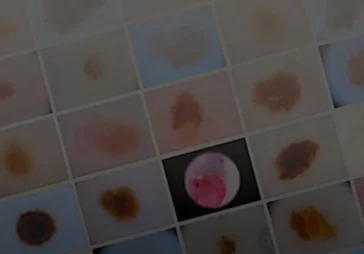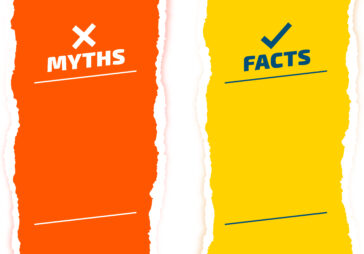When determining skin type, two different conversations quickly surface. There is the more beauty-focused skin type discussion that refers to how our skin feels, how much oil it produces and how it reacts to products (think: normal, dry, oily, etc.) and then there is the skin type discussion that focuses on how our skin reacts to the sun and its susceptibility to skin cancer symptoms (think: fair, medium, dark, etc.) Both branches of the skin type conversation root back to our genetics.
We are born with the skin we have and cannot do much to change its natural properties. That’s why understanding the nature of our skin — in all its forms — is important for keeping it healthy and looking good.
Below, we take a look at the two kinds of skin types and explain how you can determine and care for your individual type. For our purposes, we are going to refer to the two branches as “sun exposure skin type” and “beauty skin type.” But even though we are dividing them, it’s important to remember that every feature of our skin is intimately connected, and the way our skin reacts to beauty products may be closely related to how it responds to the sun.
Sun Exposure Skin Type by Fitzpatrick scale
The most widely used system for determining skin type and how it will react to the sun is the Fitzpatrick scale. Created by Harvard dermatologist, Thomas B. Fitzpatrick, in 1975, the scale was developed to determine the response of skin types to ultraviolet light. Dermatologists realized that looking at hair and eye color alone as a way to predict skin sensitivity to the sun was ineffective. They made this scale inclusive by looking at how patients’ skin reacted to the sun and cataloguing responses into a general scale.
The Fitzpatrick scale is divided into six different types. Check out the different indicators for each type to determine which category your skin falls into.
Once you know where you fall on the scale, it’s important to know how to care for your skin type:
Type 1: need to be the most careful in the sun. With the least amount of melanin in your skin, you are the most vulnerable to skin cancer. Try to use a sunscreen with a SPF of 30+ and seek shade whenever you are out in the sun. Be sure to check your skin head-to-toe each month for suspicious spots or moles.
Type 2: are also very susceptible to skin cancer and should practice precaution in the sun. While your fair skin will tan occasionally, it is good to wear a SPF of 30+ when in the sun and avoid being in direct sunlight for extended periods. Be sure to conduct regular, head-to-toe skin checks each month as well.
Type 3: As a type 3, you may burn at the beginning of the summer but tan easily afterwards. Your medium to olive skin tone is more protected than types 1 & 2 but it still requires a strong SPF of at least 30+ to stay safe. Try to check your skin for moles and spots every month, or at least every three months, to prevent skin cancer.
Type 4: Your medium-brown skin tans easily and rarely burns. You are less likely to get skin cancer, but that doesn’t mean you shouldn’t protect your skin from the sun’s harmful UV rays. Use an SPF of at least 15+ every day and avoid direct sun exposure.
Type 5: Type 5 skin tans very easily and seldom burns. Skin cancer is more rare for your skin type, but when skin cancer does occur it is usually detected at a later and higher-risk stage, usually on areas not directly exposed to the sun such as the palms of the hands. Use an SPF of 15+ while outside, and perform skin checks at least every three months to ensure that nothing goes undetected.
Type 6: As the darkest skin type, you almost never burn and tan very easily. But just because you never burn, doesn’t mean you are free of skin cancer risk. Still practice caution and use an SPF of 15+ to prevent damage to skin cells. Like Type 5, you are also more at risk for skin cancer in less exposed skin areas. Check your skin often for any changes or suspicious moles or spots.
To get a more accurate idea of which type you are, take the Fitzpatrick skin type test.
Beauty Skin Type
Now that you know how your skin fairs in the sun, it’s time to identify the other factors that define your skin, specifically the skin on your face. While most skin exhibits features of multiple categories, having an idea of how your skin normally behaves will help you know how to care for it and which products to use.
To gain the best idea of which type you have, wash your face first and let it dry. Don’t put any products on it for an hour and see how it acts naturally. This will give you a good indication of its true nature.
Normal skin type
Normal skin is not too dry or oily; it falls in that desirable in-between place. Your skin normally has an even tone and a soft texture, with little flakiness. You may get an oily T-zone (the central area of your face including the chin, nose and the part of your forehead above your eyebrows) in hot weather, but generally, this area is oil-free. Lighter lotions and serums are ideal for your skin type because you don’t need much heavy product to keep your skin feeling great.
Dry skin type
Dry skin is characterized by small pores and an overall feeling of tightness. It often has more visible lines, less elasticity and a duller complexion. Moisture is key to caring for dry skin. Use lotions or creams to nourish your skin cells. If your skin feels dry but you still get breakouts, then you don’t have truly dry skin. Your skin may be feeling dry from the products you’re using.
Skin care routine for dry skin
Oily skin type
Oily skin tends to have larger pores, and a shiny, thicker feeling complexion. Blackheads and pimples are more common with this type. If you blot your face with a tissue and oil stays behind, then it’s likely that you have oily skin. Cleansing the face often and avoiding heavy creams and emollients is advised for minimizing the appearance of oil.
Oily Skin Type: how to treat and what are the symptoms
Combination skin type
While most of us have combination skin to some degree since there are more sebaceous glands around our nose, this skin type is marked by a consistently oily T-zone with dryness in other areas of the face. This is the most common skin type, and people with combination skin should consider using different products for different areas of the face to keep the skin balanced.
Additional Skin Type Factors
There are a few other features that contribute to skin type. It’s good to take these into account as well when figuring out what kind of skin you have.
Sensitive Skin
Sensitive skin reacts easily to products and can breakout in rashes or become itchy. This is more likely in fair to medium skinned people but any skin type can have sensitivities. If you have sensitive skin, avoid harsh products and search for products that don’t clog or irritate the skin.
Acne-Prone
Skin can also be acne-prone. Acne of all kinds can occur at any age and on any area of the skin. Oily skin types are more likely to have acne but it can occur with all skin types. Consult a dermatologist to find an acne product and care routine that works for your unique skin problems.
Understanding all of the features of your skin may seem like a lot of work, but it is the best thing you can do to care for it properly. Once you understand how your skin responds to different elements, you can zero in on what products, treatments and safety precautions are ideal for you.
What kind of skin do you have? What are the best ways you’ve found to care for it? Let us know in the comments.
Check out more skincare tips from Skinive!










